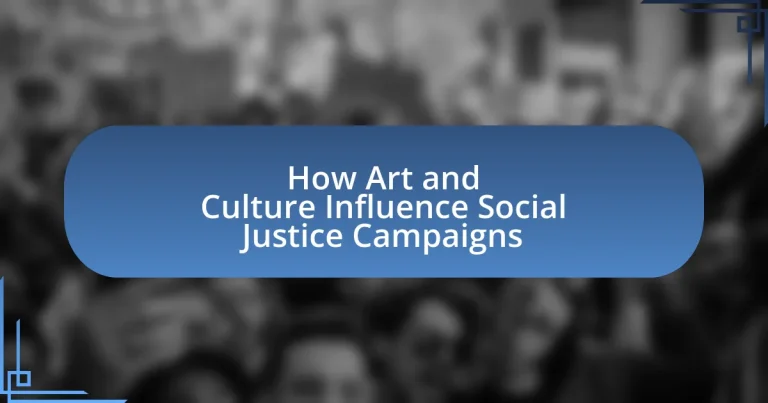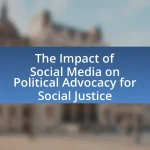Art and culture play a crucial role in shaping social justice campaigns by serving as powerful tools for expression, awareness, and mobilization. Various artistic mediums, including visual art, music, and performance, effectively communicate complex social issues, fostering empathy and understanding among diverse audiences. The article explores how artistic expression advocates for social justice, the impact of visual art on public perception, the importance of cultural representation, and the influence of historical contexts on contemporary activism. Additionally, it examines the challenges artists face, the significance of community engagement, and best practices for integrating art into social justice initiatives, highlighting successful collaborations between artists and activists.
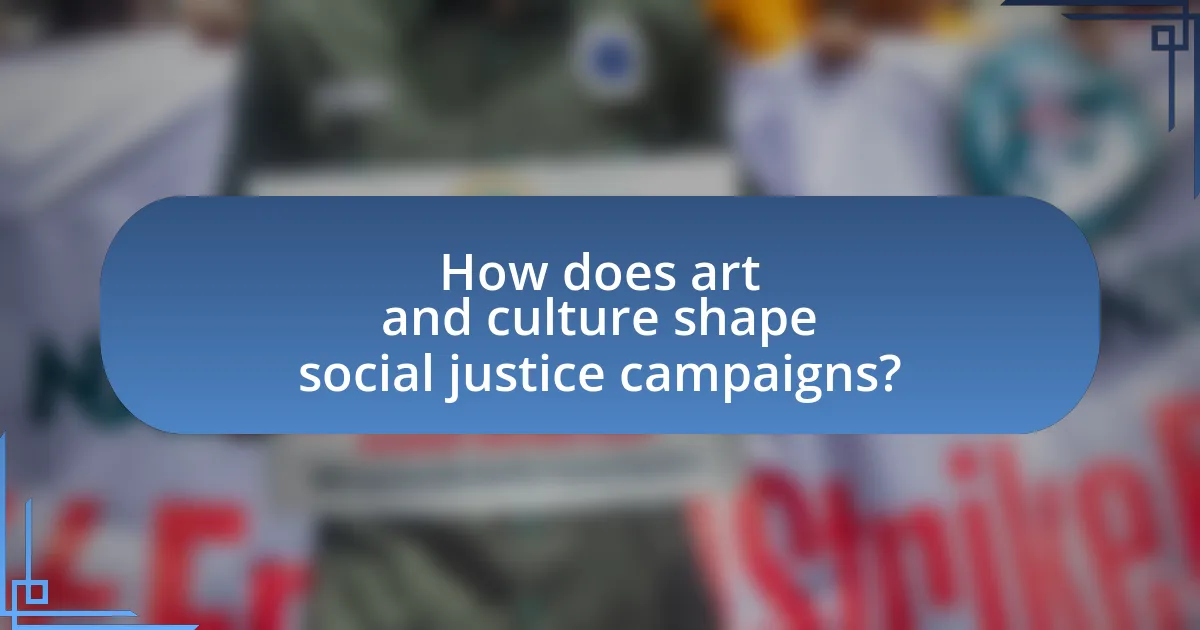
How does art and culture shape social justice campaigns?
Art and culture significantly shape social justice campaigns by providing powerful tools for expression, awareness, and mobilization. Artistic mediums such as visual art, music, and performance can convey complex social issues in relatable ways, fostering empathy and understanding among diverse audiences. For instance, the use of street art during the Black Lives Matter movement has effectively highlighted systemic racism and police brutality, engaging communities and sparking dialogue. Additionally, cultural narratives and symbols can unify individuals around a common cause, as seen in the global response to the LGBTQ+ rights movement, where cultural representations have played a crucial role in advocating for equality and acceptance. These elements demonstrate that art and culture not only amplify voices but also catalyze action, making them integral to the success of social justice campaigns.
What role does artistic expression play in advocating for social justice?
Artistic expression serves as a powerful tool for advocating social justice by raising awareness, fostering empathy, and mobilizing communities. Through various forms such as visual art, music, and performance, artists can communicate complex social issues in accessible ways, making them relatable to a broader audience. For instance, the use of street art during the Black Lives Matter movement has effectively highlighted systemic racism and police brutality, engaging the public in critical conversations. Additionally, studies show that art can evoke emotional responses that inspire action; research published in the Journal of Social Issues indicates that art can significantly increase individuals’ willingness to engage in social activism. Thus, artistic expression not only amplifies marginalized voices but also catalyzes social change by connecting people to the causes they support.
How do different art forms contribute to social justice narratives?
Different art forms contribute to social justice narratives by providing platforms for marginalized voices, fostering empathy, and facilitating dialogue. Visual arts, such as murals and photography, often depict social issues, raising awareness and prompting community engagement. For instance, the mural movement in the 1970s in the United States highlighted civil rights struggles, effectively communicating messages of resistance and hope.
Performing arts, including theater and dance, can dramatize social injustices, allowing audiences to experience the emotional weight of these issues firsthand. The play “The Vagina Monologues” has been instrumental in addressing violence against women, sparking conversations and activism globally.
Literature, through poetry and prose, articulates personal and collective experiences of oppression, inspiring readers to reflect and act. The works of authors like James Baldwin and Audre Lorde have profoundly influenced social justice movements by articulating the complexities of race, gender, and sexuality.
Overall, these art forms not only document social injustices but also mobilize communities, making them essential tools in the pursuit of social justice.
What impact does visual art have on public perception of social issues?
Visual art significantly shapes public perception of social issues by providing a powerful medium for communication and engagement. Through visual representation, artists can evoke emotions, provoke thought, and inspire action regarding social injustices. For instance, the use of murals and installations in urban areas often highlights issues such as poverty, racism, and inequality, making these topics more accessible and relatable to the public. Research indicates that visual art can increase awareness and empathy, as seen in campaigns like the AIDS Memorial Quilt, which transformed public understanding of the AIDS crisis by personalizing the impact of the epidemic through individual stories represented in fabric. This demonstrates that visual art not only raises awareness but also fosters a deeper connection to social issues, ultimately influencing public discourse and policy.
Why is cultural representation important in social justice movements?
Cultural representation is crucial in social justice movements because it ensures that diverse voices and experiences are acknowledged and valued, fostering inclusivity and understanding. When marginalized groups see themselves represented in art and activism, it validates their struggles and promotes solidarity among different communities. Research indicates that representation can enhance the effectiveness of social justice campaigns; for instance, a study by the University of Southern California found that diverse narratives in media can significantly influence public perception and policy change. This highlights that cultural representation not only empowers individuals but also drives systemic change by challenging stereotypes and promoting empathy.
How does cultural identity influence activism strategies?
Cultural identity significantly influences activism strategies by shaping the values, beliefs, and communication styles of activist groups. Activists often draw upon their cultural narratives and symbols to resonate with their communities, thereby enhancing engagement and mobilization. For instance, the Civil Rights Movement in the United States utilized African American cultural expressions, such as music and art, to convey messages of resistance and solidarity, which helped to unify diverse groups under a common cause. This strategic use of cultural identity not only fosters a sense of belonging but also amplifies the impact of the activism by making it relatable and meaningful to those within the cultural group.
What are the consequences of underrepresentation in social justice campaigns?
Underrepresentation in social justice campaigns leads to a lack of diverse perspectives, which can result in ineffective advocacy and policies that do not address the needs of all communities. This absence of representation often perpetuates systemic inequalities, as marginalized groups may feel excluded from the conversation and decision-making processes. For instance, studies have shown that campaigns lacking diverse voices tend to overlook critical issues affecting specific populations, thereby failing to mobilize necessary support and resources. Furthermore, underrepresentation can diminish public trust in social justice movements, as individuals from underrepresented groups may perceive these campaigns as not genuinely reflecting their interests or experiences.
How do historical contexts affect the relationship between art and social justice?
Historical contexts significantly shape the relationship between art and social justice by influencing the themes, messages, and mediums artists choose to express societal issues. For instance, during the Civil Rights Movement in the 1960s, artists like Jacob Lawrence and Faith Ringgold used their work to highlight racial injustices and advocate for equality, reflecting the urgent social climate of the time. This connection is further evidenced by the use of protest art in contemporary movements, such as Black Lives Matter, where artists create pieces that respond to systemic racism and police brutality, demonstrating how historical events inform artistic expression and activism. Thus, the interplay between art and social justice is deeply rooted in the specific historical circumstances that demand attention to social issues.
What lessons can be learned from past social justice movements and their artistic expressions?
Past social justice movements and their artistic expressions teach the importance of creativity in advocacy and the power of storytelling to mobilize communities. For instance, the Civil Rights Movement utilized music, literature, and visual arts to convey messages of equality and resistance, exemplified by songs like “We Shall Overcome,” which became an anthem for change. Additionally, the use of visual art, such as the works of artists like Jacob Lawrence, illustrated the struggles and aspirations of African Americans, fostering empathy and understanding among broader audiences. These artistic expressions not only documented the movements but also inspired collective action, demonstrating that art can serve as a catalyst for social change by engaging emotions and raising awareness.
How have historical events shaped contemporary art used in social justice?
Historical events have significantly shaped contemporary art used in social justice by providing context, themes, and urgency to artistic expressions. For instance, the Civil Rights Movement in the 1960s inspired artists like Faith Ringgold and Charles White to create works that addressed racial inequality and social justice, using their art as a platform for activism. Similarly, the feminist movements of the 1970s led to the emergence of artists such as Judy Chicago, who utilized art to challenge gender norms and advocate for women’s rights. These historical movements not only influenced the subject matter of contemporary art but also established a tradition of using art as a tool for social change, evident in current works that address issues like climate change, immigration, and systemic racism. The legacy of these events continues to resonate, as artists today draw upon historical struggles to inform their work and engage audiences in ongoing social justice dialogues.
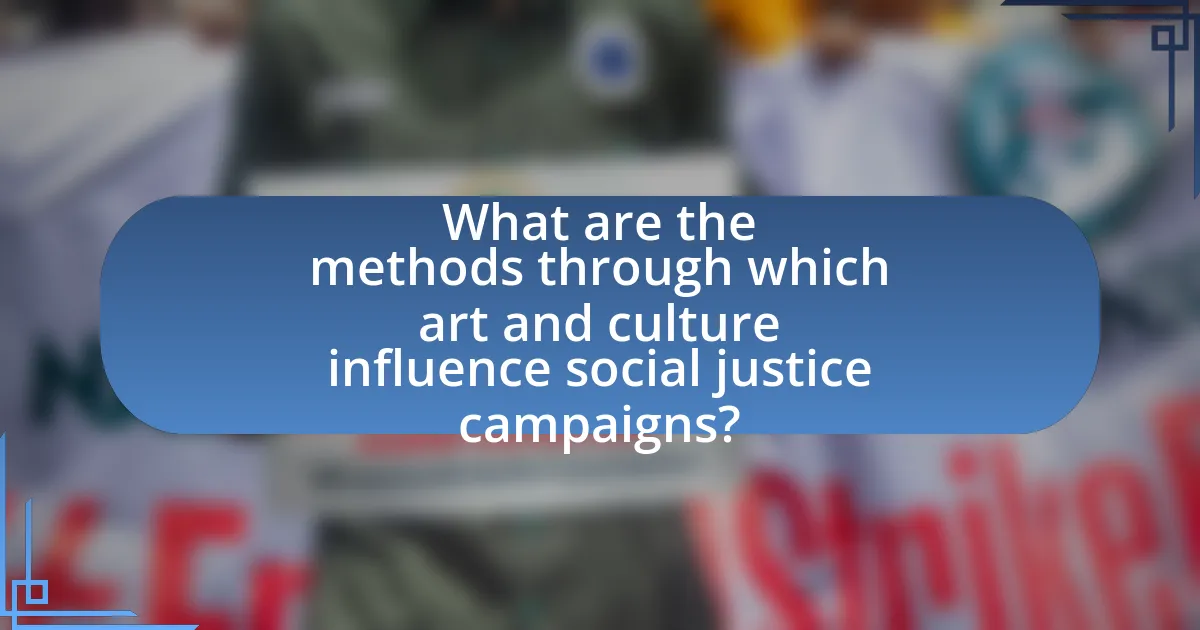
What are the methods through which art and culture influence social justice campaigns?
Art and culture influence social justice campaigns through methods such as storytelling, visual representation, and community engagement. Storytelling, often conveyed through literature, theater, and film, allows individuals to share personal experiences that highlight social injustices, fostering empathy and understanding among audiences. Visual representation, including murals, photography, and graphic design, serves to communicate powerful messages quickly and effectively, often capturing attention and sparking dialogue around critical issues. Community engagement, facilitated by art workshops and cultural events, empowers marginalized groups to express their voices and advocate for change, creating a collective identity that strengthens social movements. These methods have been evidenced in campaigns like the “Black Lives Matter” movement, where art has played a crucial role in mobilizing support and raising awareness globally.
How do collaborations between artists and activists enhance social justice efforts?
Collaborations between artists and activists enhance social justice efforts by merging creative expression with advocacy, thereby amplifying messages and reaching broader audiences. Artists utilize their platforms to convey complex social issues in relatable and impactful ways, making the messages more accessible. For instance, the collaboration between the artist Ai Weiwei and various human rights organizations has brought global attention to issues like refugee crises and freedom of expression, effectively mobilizing public support and action. This synergy not only raises awareness but also fosters community engagement, as seen in initiatives like the “Art for Justice Fund,” which combines artistic endeavors with criminal justice reform efforts, demonstrating the tangible impact of such collaborations on policy change and societal attitudes.
What are some successful examples of artist-activist partnerships?
Successful examples of artist-activist partnerships include the collaboration between the artist Ai Weiwei and various human rights organizations, which has raised global awareness about issues such as refugee crises and government oppression. Another notable partnership is between the musician Beyoncé and the Black Lives Matter movement, where her music and public appearances have amplified messages of racial justice and police reform. Additionally, the artist Banksy has partnered with charities like the Refugee Youth Project, using his art to highlight the plight of refugees and raise funds for support. These partnerships demonstrate how artists leverage their platforms to advocate for social change effectively.
How can community engagement through art amplify social justice messages?
Community engagement through art amplifies social justice messages by fostering collective identity and encouraging dialogue among diverse groups. Art serves as a powerful medium for expression, allowing communities to visually articulate their experiences and struggles related to social justice issues. For instance, public murals and community art projects often reflect local histories and injustices, creating a shared narrative that resonates with both participants and viewers. Research indicates that participatory art initiatives can increase awareness and mobilize action; a study by the University of Southern California found that community art projects significantly enhanced civic engagement and advocacy efforts. By transforming personal stories into public art, communities can challenge dominant narratives and inspire broader societal change.
What platforms are most effective for disseminating art related to social justice?
Social media platforms, particularly Instagram, Twitter, and Facebook, are the most effective for disseminating art related to social justice. These platforms enable artists to reach a wide audience quickly, facilitating the sharing of visual content that can evoke emotional responses and drive engagement. For instance, Instagram’s visual-centric format allows artists to showcase their work and connect with followers through hashtags related to social justice movements, such as #BlackLivesMatter or #MeToo. According to a study by the Pew Research Center, 69% of adults in the U.S. use Facebook, making it a powerful tool for organizing and mobilizing communities around social justice issues. Additionally, Twitter’s real-time nature allows for rapid dissemination of art and messages, amplifying voices and fostering discussions on social justice topics.
How do social media and digital art play a role in modern campaigns?
Social media and digital art are integral to modern campaigns by enhancing visibility and engagement. Social media platforms allow campaigns to reach a broader audience quickly, facilitating real-time interaction and feedback. Digital art, including graphics and animations, captures attention and conveys complex messages effectively, making them shareable and memorable. For instance, campaigns like #BlackLivesMatter utilize striking visuals and social media to mobilize support and raise awareness, demonstrating the power of these tools in driving social change.
What traditional platforms still hold significance for social justice art?
Traditional platforms that still hold significance for social justice art include public murals, community theaters, and print media such as newspapers and zines. Public murals serve as accessible visual statements that engage communities and provoke dialogue on social issues, exemplified by the rise of muralism in urban areas during the civil rights movement. Community theaters provide a space for performance art that addresses social justice themes, allowing local voices to share their narratives and experiences. Print media, particularly independent newspapers and zines, have historically been used to disseminate information and raise awareness about social justice issues, as seen in the activism of the 1960s and 1970s. These platforms continue to play a crucial role in amplifying marginalized voices and fostering community engagement in social justice movements.
How can art be used as a tool for education in social justice?
Art can be used as a tool for education in social justice by facilitating critical dialogue, raising awareness, and fostering empathy among diverse audiences. Through visual arts, performances, and literature, artists can convey complex social issues, making them accessible and relatable. For instance, the “Art for Social Change” initiative has demonstrated that community murals can engage local populations in discussions about systemic inequality, thereby educating them on social justice topics. Additionally, studies show that art-based programs in schools improve students’ understanding of social issues, as evidenced by the “Teaching for Change” program, which integrates art into curricula to promote social awareness and activism.
What are effective ways to incorporate art into educational programs about social justice?
Effective ways to incorporate art into educational programs about social justice include using visual arts, performance arts, and community art projects to engage students emotionally and intellectually. Visual arts, such as murals and graphic design, can illustrate social justice themes and provoke discussions about inequality and activism. Performance arts, including theater and spoken word, allow students to express their perspectives and experiences related to social justice issues, fostering empathy and understanding. Community art projects can involve collaboration with local artists and organizations, creating a sense of ownership and connection to the social justice topics being explored. Research shows that integrating art into education enhances critical thinking and encourages civic engagement, making it a powerful tool for social justice education.
How does art facilitate dialogue around complex social issues?
Art facilitates dialogue around complex social issues by providing a visual and emotional medium that engages audiences in critical conversations. Through various forms such as paintings, performances, and installations, art can evoke empathy and provoke thought, allowing individuals to confront difficult topics like inequality, racism, and climate change. For instance, the “Fearless Girl” statue in New York City sparked discussions about gender equality and women’s empowerment, illustrating how public art can challenge societal norms and inspire action. Additionally, studies have shown that art can enhance community engagement and foster collaboration, as seen in initiatives like the “Art for Social Change” program, which uses creative expression to address local issues and mobilize communities.
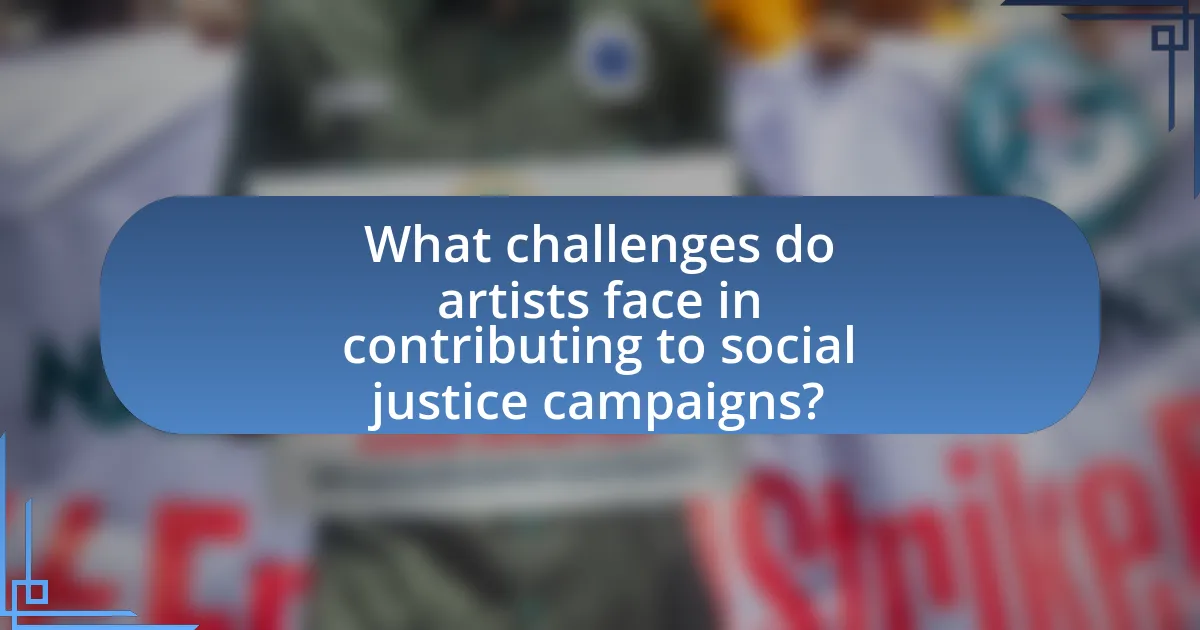
What challenges do artists face in contributing to social justice campaigns?
Artists face several challenges in contributing to social justice campaigns, including funding limitations, censorship, and the risk of alienating audiences. Funding limitations often restrict artists’ ability to produce impactful work, as many social justice initiatives lack financial support. Censorship can arise from political or social pressures, hindering artists from expressing their messages freely. Additionally, artists may risk alienating segments of their audience, which can lead to decreased support for their work and campaigns. These challenges can significantly impact the effectiveness and reach of their contributions to social justice efforts.
How do funding and resources impact artistic contributions to social justice?
Funding and resources significantly enhance artistic contributions to social justice by providing the necessary financial support and materials for artists to create impactful work. When artists receive adequate funding, they can produce high-quality projects that effectively communicate social justice themes, engage communities, and raise awareness about critical issues. For instance, the National Endowment for the Arts reported that funded projects often lead to increased public engagement and dialogue around social issues, demonstrating the direct correlation between financial support and the effectiveness of artistic contributions in social justice movements. Additionally, resources such as access to venues, materials, and technology enable artists to reach broader audiences, amplifying their messages and fostering community involvement in social justice initiatives.
What are common funding sources for art in social justice initiatives?
Common funding sources for art in social justice initiatives include government grants, private foundations, crowdfunding platforms, and corporate sponsorships. Government grants, such as those from the National Endowment for the Arts, provide financial support specifically for projects that address social issues through artistic expression. Private foundations, like the Ford Foundation, often allocate funds to projects that promote social equity and justice. Crowdfunding platforms, such as Kickstarter and GoFundMe, enable artists and activists to raise money directly from the public for their initiatives. Corporate sponsorships can also play a role, as businesses may support art projects that align with their corporate social responsibility goals. These funding sources collectively contribute to the sustainability and impact of art in advancing social justice causes.
How can artists overcome financial barriers to create impactful work?
Artists can overcome financial barriers to create impactful work by leveraging grants, crowdfunding, and community partnerships. Grants from organizations such as the National Endowment for the Arts provide financial support specifically for artistic projects, enabling artists to focus on their creative endeavors without the burden of financial constraints. Crowdfunding platforms like Kickstarter and GoFundMe allow artists to raise funds directly from their audience, fostering a sense of community investment in their work. Additionally, forming partnerships with local businesses or non-profits can provide resources and funding opportunities, as seen in initiatives where artists collaborate with social justice organizations to amplify their messages while securing financial backing. These strategies collectively empower artists to produce meaningful work that resonates within social justice campaigns.
What risks do artists encounter when addressing social justice themes?
Artists encounter significant risks when addressing social justice themes, including censorship, backlash, and personal safety threats. Censorship can occur when authorities or institutions suppress artistic expression that challenges the status quo, as seen in cases where artworks have been removed from galleries or festivals due to political content. Backlash may manifest in public criticism or social media harassment, which can damage an artist’s reputation and career. Additionally, artists may face personal safety threats, particularly in oppressive regimes where expressing dissenting views can lead to violence or imprisonment, as evidenced by the experiences of artists in countries with strict government control over free speech.
How can censorship affect the expression of social justice through art?
Censorship can significantly hinder the expression of social justice through art by restricting the themes and messages that artists can convey. When governments or institutions impose censorship, they often silence critical voices and limit the portrayal of social issues, which can prevent important conversations about inequality, discrimination, and human rights from taking place. For instance, in countries with strict censorship laws, artists may face repercussions for addressing topics like police brutality or systemic racism, leading to a homogenization of artistic expression that fails to challenge the status quo. Historical examples include the censorship of works by artists like Ai Weiwei in China, whose art critiques government policies and human rights abuses, illustrating how censorship can stifle vital social justice narratives.
What are the personal and professional consequences for artists involved in activism?
Artists involved in activism often face significant personal and professional consequences, including social backlash, loss of commercial opportunities, and heightened scrutiny of their work. For instance, artists may experience alienation from certain audiences or industry stakeholders who disagree with their political stances, leading to a decline in ticket sales or sponsorships. Additionally, they may encounter threats or harassment, impacting their mental health and personal safety. Professionally, while some artists gain recognition and a loyal following for their activism, others may find their careers hindered by being labeled as controversial or polarizing figures. This duality is evident in cases like the musician Beyoncé, who faced both acclaim and criticism for her politically charged performances, illustrating the complex landscape artists navigate when engaging in activism.
How can artists navigate the balance between activism and artistic integrity?
Artists can navigate the balance between activism and artistic integrity by consciously integrating their social messages into their creative processes while maintaining their unique artistic voice. This approach allows artists to express their beliefs without compromising their artistic vision. For instance, artists like Ai Weiwei have successfully combined activism with art, using their platforms to address social issues while producing critically acclaimed works. By prioritizing authenticity and ensuring that their activism aligns with their artistic style, artists can engage audiences effectively and contribute to social justice movements without sacrificing their integrity.
What strategies can artists employ to maintain authenticity in their work?
Artists can maintain authenticity in their work by staying true to their personal experiences and values. This involves reflecting on their unique backgrounds and perspectives, which can lead to genuine expressions that resonate with audiences. For instance, artists who draw from their cultural heritage often create more impactful and relatable art, as seen in the works of artists like Frida Kahlo, whose personal struggles and identity shaped her iconic pieces. Additionally, engaging with their communities and addressing relevant social issues can further enhance authenticity, as artists like Ai Weiwei demonstrate through their activism and art that confronts political injustices. By prioritizing personal truth and community engagement, artists can create work that is both authentic and socially relevant.
How can artists ensure their messages resonate without compromising their vision?
Artists can ensure their messages resonate without compromising their vision by maintaining authenticity while engaging with their audience. Authenticity allows artists to express their true intentions and beliefs, which fosters a genuine connection with viewers. Engaging with the audience through feedback and dialogue can help artists understand what resonates while still staying true to their core message. For instance, artists like Ai Weiwei have successfully communicated powerful social justice themes by integrating personal experiences and cultural context into their work, thereby resonating deeply with audiences without sacrificing their artistic integrity.
What are best practices for integrating art and culture into social justice campaigns?
Best practices for integrating art and culture into social justice campaigns include fostering community engagement, utilizing diverse artistic mediums, and ensuring representation of marginalized voices. Community engagement is crucial as it builds trust and encourages participation; for instance, projects like the “People’s Climate March” effectively used art to mobilize diverse groups. Utilizing diverse artistic mediums, such as visual arts, music, and performance, can enhance emotional resonance and reach wider audiences, as seen in campaigns like “The Art of Protest.” Ensuring representation of marginalized voices not only validates their experiences but also strengthens the campaign’s authenticity, exemplified by initiatives like “Black Lives Matter,” which prominently feature art created by Black artists. These practices collectively enhance the impact and effectiveness of social justice campaigns.
How can organizations effectively collaborate with artists for social change?
Organizations can effectively collaborate with artists for social change by establishing clear goals, fostering open communication, and creating mutually beneficial partnerships. Clear goals ensure that both parties understand the intended impact of their collaboration, such as raising awareness about specific social issues or mobilizing community action. Open communication allows for the exchange of ideas and feedback, which can enhance the creative process and ensure that the artistic expression aligns with the organization’s mission. Additionally, creating mutually beneficial partnerships, where artists receive support and resources while organizations gain access to innovative perspectives and outreach methods, can lead to more impactful social change initiatives. For instance, the collaboration between the nonprofit organization Art for Justice Fund and various artists has successfully raised awareness and funds for criminal justice reform, demonstrating the effectiveness of such partnerships in driving social change.
What role does community feedback play in shaping art for social justice?
Community feedback is crucial in shaping art for social justice as it ensures that the artwork resonates with the lived experiences and needs of the community it aims to represent. This participatory approach allows artists to incorporate diverse perspectives, making the art more relevant and impactful. For instance, projects like the “Art for Social Change” initiative have demonstrated that when artists engage with community members through workshops and discussions, the resulting artwork often addresses specific social issues more effectively, leading to greater community engagement and advocacy. This collaborative process not only validates the voices of marginalized groups but also fosters a sense of ownership and empowerment within the community, ultimately enhancing the art’s ability to drive social change.
